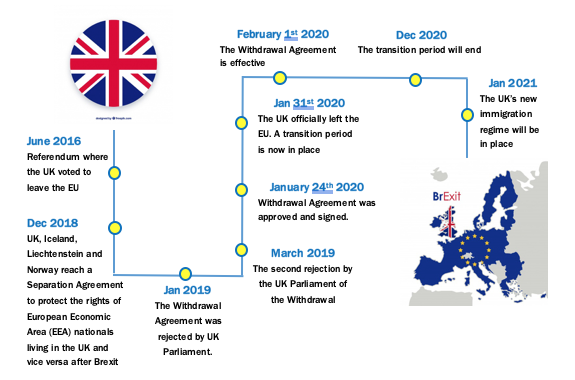WuXi Biologics
Offering End-to-End Solutions
监管机构资讯
WuXi Biologics Regulatory Updates
Quarter 1 2020 – Brexit Special Topic: Pharmaceutical Regulatory Schemes of EMA and MHRA Post-Brexit
Purpose & Disclaimer: This special topic of the newsletter provides a general introduction on Brexit and pharmaceutical regulatory schemes of EMA and MHRA post-Brexit. This is the Regulatory Affairs team’s interpretation of points that may have current or prospective impact to WuXi Biologics. The points listed should neither be considered comprehensive nor exhaustive.
1. General Introduction
Brexit – British exit – refers to the UK leaving the European Union (EU). A public vote (known as referendum) was held in June 2016, when 17.4 million people opted for Brexit, which gave the Leave side 52% of the voting share, compared with 48% for Remain1.
The EU was an economic and political union involving 28 European countries (now 27 after the departure of the UK). Amongst other factors, it allows free trade, as well as free movement of people to live and work in whichever country they choose. The UK joined in 1973 (when it was known as the European Economic Community) and was the first member state to withdraw1.
While the UK has agreed on the terms of its EU departure, years have been taken for both sides to negotiate many aspects of the future UK-EU relationship, including trade and tariffs, law enforcement, aviation standards and safety, supplies of electricity and gas, and licensing and regulation of medicines, etc1. Figure 1 below describes the key milestones for the Brexit process since 20162. On January 31, 2020, the UK formally left the EU. The withdrawal agreement establishes the terms of the UK’s departure from the EU, including a transition period that began on February 1, 2020, and is scheduled to end on December 31, 2020.

Figure 1 Key Milestones for the Brexit Process Since 20162
2. Pharmaceutical Regulatory Schemes Post-Brexit
2.1 European Medicines Agency (EMA)
The European Medicines Agency (EMA) has made preparations to ensure it continues to deliver on its mission to protect public and animal health throughout the Brexit process.
One of the consequences of Brexit was that the EMA relocated to Amsterdam, the Netherlands, in March 2019. This is in line with Regulation (EU) 2018/1718, which covers EMA’s location and seat3.
In addition, the UK no longer participates in EU institutions after its withdrawal from the EU on January 31, 2020. This means that as of February 1, 2020, no one who represents the UK, or is appointed or nominated by the UK can participate in any EMA scientific committee meeting, working party meeting or in the Agency’s Management Board3.
In preparation for Brexit, the EU27 Member States and EMA redistributed the UK’s portfolio of medicines to other EU Member States. This involved transferring over 370 centrally authorized products to rapporteurs (one of the two members of a committee or working party who leads the evaluation of an application) and co-rapporteurs (one of the two members of a committee or working party leading the assessment of an application) from the EU27 plus Iceland and Norway3.
EMA continues to operate in accordance with the timelines set by its rules and regulations throughout the Brexit process.
2.2 Medicines and Healthcare Products Regulatory Agency (MHRA)
During the transition period (ending in December 2020), EU pharmaceutical law will be applicable to the UK. UK is currently working on its legal basis for pharmaceutical regulations after the transition period.
In addition, under the terms of the Withdrawal Agreement, the UK shall not act as a leading authority for risk assessments, examinations, approvals, and authorizations at the level of the Union or of its’ Member States during the transition period4. This means that the UK can only be a concerned member state (CMS) when participating in the decentralized and mutual recognition licensing procedures during the transition period, while one EU member state will lead the assessment of application as reference member state (RMS)4. UK authorities will remain available to provide expert advice during this period.
3. Regulatory Agencies: Guidance for Sponsors
3.1 Brexit-related Guidance from European Medicines Agency (EMA)
Since 2017, the European Medicines Agency (EMA) and the European Commission (EC) have been providing guidance to help pharmaceutical companies responsible for both human and veterinary medicines prepare for the consequences of Brexit. Below briefly summarizes the EMA’s current recommendations for sponsors of the pharmaceutical industry.
During the transition period, EU pharmaceutical law will be applicable to the UK. This means that pharmaceutical companies have until December 31, 2020 to make the necessary changes to ensure that their centrally and nationally authorized medicines comply with EU law and can remain on the EU market5.
For example, the following entities can still be located in the UK until December 31, 2020:
- marketing authorization holders and applicants;
- orphan designation holders;
- qualified persons for pharmacovigilance (QPPVs);
- veterinary medicines: minor use/minor species (MUMS)/limited markets classification holders;
- companies’ manufacturing and batch release sites.
Each batch of finished product must be certified by a Qualified Person (QP) within the European Economic Area (EEA) before being released for placing on the market in the EEA or for export. Also, the site for batch control needs to be located in the EEA or a country covered by a mutual recognition agreement. Since UK will no longer be treated as part of the EEA after the transition period6, products that only have batch release and quality control testing sites for finished product in the UK will have to change the QP batch release and testing sites to a country located in EEA before December 31, 2020.
3.1.2 Guidance on Centrally Authorized Products (Centralised Procedure)
In the EU, a biological product is centrally authorized by EMA/EC (using Centralized Procedure). EMA and EC are currently updating the Brexit-related guidance documents listed below, and will publish the updates shortly. Sponsors should check EMA’s website about Brexit- related guidance for companies regularly5. For detailed information. Please refer to the two guidance documents listed below:
A. Notice to Stakeholders: Withdrawal of the United Kingdom and EU Rules for Medicinal Products for Human Use and Veterinary Medicinal Products (Last Updated: March 2020)
- This guidance contains information on the legal considerations after the end of the transition period, including issues related to marketing authorizations and related procedures, manufacturing and importation of finished products, Official Control Authority Batch Release (OCABR), orphan medicines, and inspection results amongst other information. This guidance also discusses the provisions for products placed on the market before the end of the transition period.
B. Practical Guidance for Procedures Related to Brexit for Medicinal Products for Human and Veterinary Use within the Framework of the Centralised Procedure (Last Updated: March 2020)
- This document provides procedural and practical guidance regarding submission of changes and related fees. It addresses the implications of the withdrawal agreement and the transition period provided for therein. Key topics include grouping, classification and submission of Brexit-related variations, submission for the transfer of a marketing authorization, notifying the change of Official Medicines Control Laboratory (OMCL) currently in UK, and the impact of the UK’s withdrawal on ongoing applications that include manufacturing sites with GMP certificates issued by UK authorities.
3.1.3 Guidance on Nationally Authorized Products
The Coordination Group for Mutual Recognition and Decentralized Procedures – Human (CMDh) has published information for marketing authorization holders of nationally authorized products. For more information, please refer to: CMDh: Brexit-related information for nationally authorized human medicines.
3.1.4 Submission of Brexit-related Type I Variations
Table 1 below summarizes different types of post-authorization/post-approval changes submitted to the EMA. For reference, types of post-approval submissions to the U.S. FDA are also presented. For detailed information, please refer to classification guidance on minor variations of Type IA, minor variations of Type IB and Major.
Table 1: Different Types of Post-Authorization/Post-Approval Changes for Medicinal Products Submitted to (a) the EMA, (b) the US FDA
(a)
| Impact on the Quality, Safety or Efficacy | Variation Type Submitted to EMA |
|---|---|
| Minor | Type IA |
| Type IAIN | |
| Type IB | |
| Major | Type II |
(b)
| Impact on the Quality, Safety or Efficacy | Post-approval Changes Submitted to the U.S. FDA |
|---|---|
| Minor | Annual Report (AR) |
| Moderate | Changes Being Effected (CBE) in 30 Days/Changes Being Effected Supplements |
| Critical | Prior Approval Supplement (PAS) |
EMA encourages marketing authorization holders to submit Brexit-related type IA and type IB variations as early as possible, to enable EMA to confirm compliance with regulatory and legal requirements by the end of the Brexit transition period5.
According to EU law, the marketing authorization holder, QPPV, pharmacovigilance system master file (PSMF) and certain manufacturing sites need to be based in the EEA for a company to be able to market a medicine in the EU (the UK ceased to be a Contracting Party to the EEA Agreement after its withdrawal from the EU on January 31, 2020 and is therefore no longer part of the EEA). For more information and guidance, please refer to Type-IA Variations: Questions and Answers, and Type-IB Variations: Questions and Answers.
Key questions addressed by these two guidances include:
- When shall I submit my Type-I variation?
- Can I group the submission of Type-I variations? Can they be grouped with other types of variation?
- Is the (co-)rapporteur involved in Type-I variations?
- How shall I present and submit my Type-I variation(s)?
- How will my Type-I variation be handled?
- Can my Type-I be part of work-sharing?
- What should I do in case of an unfavorable outcome for my Type-IA or –IAIN variation?
- How and when will the updated product-information annexes become part of the marketing authorization?
- Who should I contact if I have a question when preparing my application or during the procedure?
Please refer to the links above for detailed answers to these questions.
3.2 Medicines and Health Products Regulatory Agency (MHRA) Guidance on Application for a License to Market a Medicine Post-Brexit
MHRA’s guidance, Apply for a License to Market a Medicine in the UK (last updated: February 2020), discusses how to license a medicine for sale in the UK and Europe post-Brexit, including applications through national, centralized and decentralized procedures4. In summary, the specific application procedure taken depends on the license needed:
- Decentralized procedure is used if the applicant wants to market the medicine in the UK and other named EU countries. The UK can only be a concerned member state (CMS) and cannot act as a rapporteur or co-rapporteur during the transition period, while one other state will lead the assessment of application as the reference member state (RMS). The procedure takes up to 210 days. If the application is approved, the UK and each CMS will issue a national license for the product within 30 days of the approval being granted.
- Mutual recognition procedure is adopted if the applicant already has a national license in 1 or more EU countries but wants to market it in other countries (the UK can only be a CMS during the transition period and cannot act as a rapporteur or co-rapporteur). The application process takes up to 90 days.
- National procedure is used if the applicant wants to market a medicine only in the UK. For first-time applicants, email Data@mhra.gov.uk to obtain a 5-digit company number, and get a PL number from the MHRA Portal before submission. The application process takes up to 210 days.
- Centralized procedure is used when the applicant wants to market certain types of medicines throughout the EU, and a centralized license is mandatory for certain new active substances and biotechnology products. Centralized licenses are granted by the EMA.
4. Reference
- BCC News, Online source, https://www.bbc.com/news/uk-politics-32810887, retrieved on March 13th 2020
- Online source, https://www.fragomen.com/sites/brexit/brexit-key-milestones, retrieved on March 13th 2020
- European Medicines Agency, Brexit: the United Kingdom’s Withdrawal from the European Union, Lasted updated on March 2nd 2020, retrieved from https://www.ema.europa.eu/en/about-us/brexit-united-kingdoms-withdrawal-european-union
- Medicines and Health Products Regulatory Agency, Apply for a Licence to Market a Medicine in the UK, Lasted updated on February 18th 2020, retrieved from https://www.gov.uk/guidance/apply-for-a-licence-to-market-a-medicine-in-the-uk#applying-for-a-licence-during-the-transition-period
- European Medicines Agency, Brexit-related guidance for companies, Lasted updated on December 19th 2019, retrieved from https://www.ema.europa.eu/en/about-us/brexit-uk-withdrawal-eu/brexit-related-guidance-companies
- Frequently asked questions on EFTA, the EEA, EFTA membership and Brexit, online source, retrieved from https://www.efta.int/About-EFTA/Frequently-asked-questions-EFTA-EEA-EFTA-membership-and-Brexit-328676









